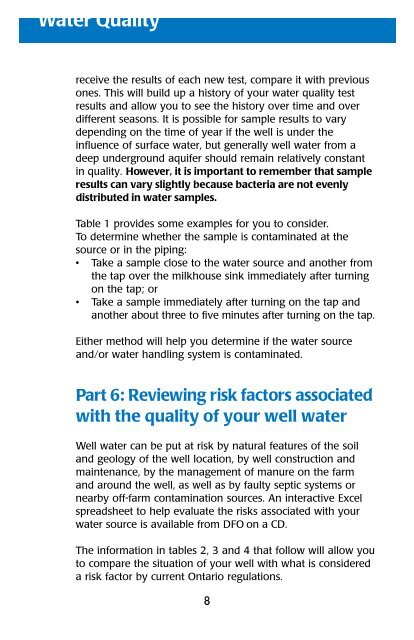Water Used To Wash Milk Contact Surfaces - Dairy Farmers of Ontario
Water Used To Wash Milk Contact Surfaces - Dairy Farmers of Ontario
Water Used To Wash Milk Contact Surfaces - Dairy Farmers of Ontario
Create successful ePaper yourself
Turn your PDF publications into a flip-book with our unique Google optimized e-Paper software.
<strong>Water</strong> Quality<br />
receive the results <strong>of</strong> each new test, compare it with previous<br />
ones. This will build up a history <strong>of</strong> your water quality test<br />
results and allow you to see the history over time and over<br />
different seasons. It is possible for sample results to vary<br />
depending on the time <strong>of</strong> year if the well is under the<br />
influence <strong>of</strong> surface water, but generally well water from a<br />
deep underground aquifer should remain relatively constant<br />
in quality. However, it is important to remember that sample<br />
results can vary slightly because bacteria are not evenly<br />
distributed in water samples.<br />
Table 1 provides some examples for you to consider.<br />
<strong>To</strong> determine whether the sample is contaminated at the<br />
source or in the piping:<br />
• Take a sample close to the water source and another from<br />
the tap over the milkhouse sink immediately after turning<br />
on the tap; or<br />
• Take a sample immediately after turning on the tap and<br />
another about three to five minutes after turning on the tap.<br />
Either method will help you determine if the water source<br />
and/or water handling system is contaminated.<br />
Part 6: Rev i ewing risk factors associated<br />
with the quality <strong>of</strong> your well water<br />
Well water can be put at risk by natural features <strong>of</strong> the soil<br />
and geology <strong>of</strong> the well location, by well construction and<br />
maintenance, by the management <strong>of</strong> manure on the farm<br />
and around the well, as well as by faulty septic systems or<br />
nearby <strong>of</strong>f-farm contamination sources. An interactive Excel<br />
spreadsheet to help evaluate the risks associated with your<br />
water source is available from DFO on a CD.<br />
The information in tables 2, 3 and 4 that follow will allow you<br />
to compare the situation <strong>of</strong> your well with what is considered<br />
a risk factor by current <strong>Ontario</strong> regulations.<br />
8
















